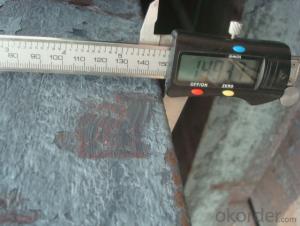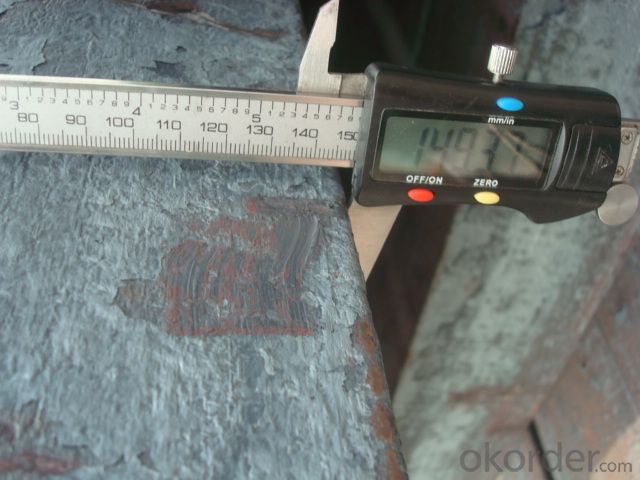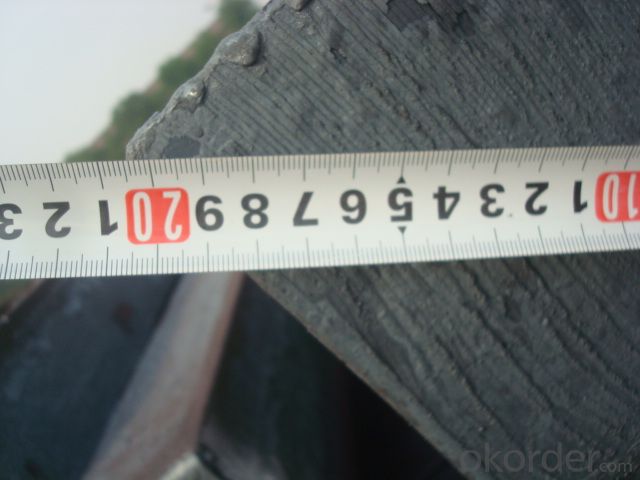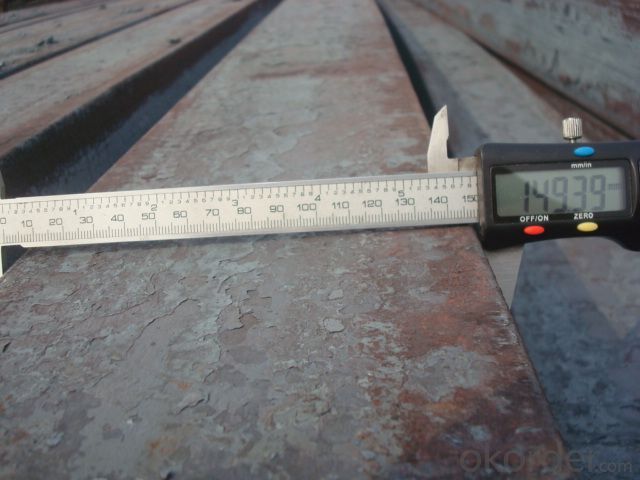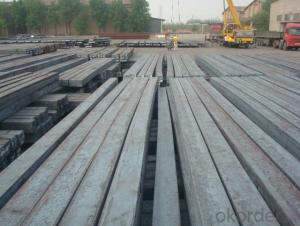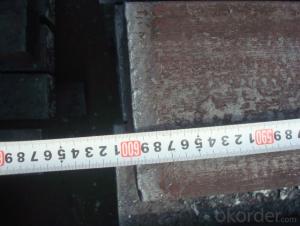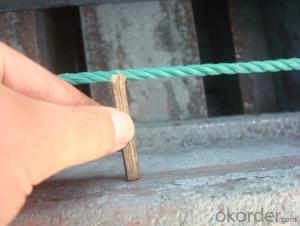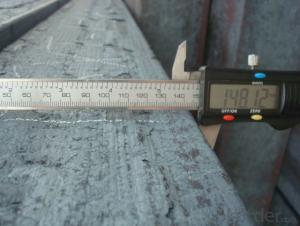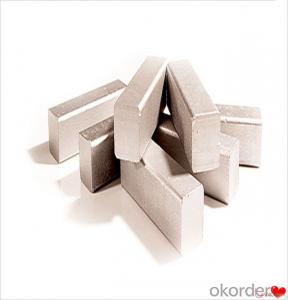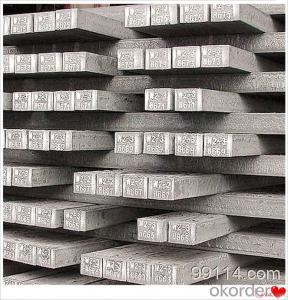Prime Steel Billet Q275, 20MnSi, 5SP,Q235 for great sale
- Loading Port:
- Tianjin
- Payment Terms:
- TT OR LC
- Min Order Qty:
- 1000 m.t.
- Supply Capability:
- 20000 m.t./month
OKorder Service Pledge
OKorder Financial Service
You Might Also Like
STEEL BILLET
1.Brief description
Steel billet(ingot) by cogging or breakdown of semi-finished products, is the raw material of all kinds of steel mill. Billet section of square, round, flat, rectangular and abnormity of several kinds of, mainly related to the shape of rolled products.
2.Features
Rectangular billet continuous casting billet and mainly general carbon steel, low carbon low silicon cold-rolled material, high quality carbon structural steel, high strength low alloy steel, special steel, etc.
The billet is mainly divided into two kinds from the shape:
Slab: cross section width and height of the ratio of the larger, mainly used for rolling plate.
Billet: equal cross section width and height, or a huge difference, mainly used for rolling steel, wire rod. ,
Steel billets have distinct characteristics as compared with already furnished steel bars and products. Billets have a specific grain structure, which enables the metal to be processed more intricately. Steel billets are also known for their malleability and ductility, especially when exposed to varying temperatures during shaping and molding.
3.Processing
Steel billets are considered fresh and raw, and they must undergo a series of manufacturing processes before they can be used for various purposes. Billets are made by means of freezing molten liquid, and are later exposed to extremely low temperatures in order to allow the metal to take shape and solidify in chemical structure. The temperature manipulates the metal's physical properties, and tones its strength and durability. The subsequent processes provide the metal's curved mold design so that it can fit the allotted space provided by other machines, which complete the finishing procedures.
4.Pictures
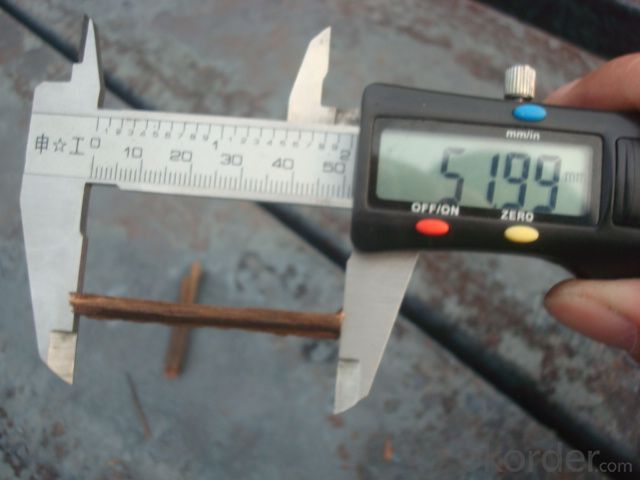
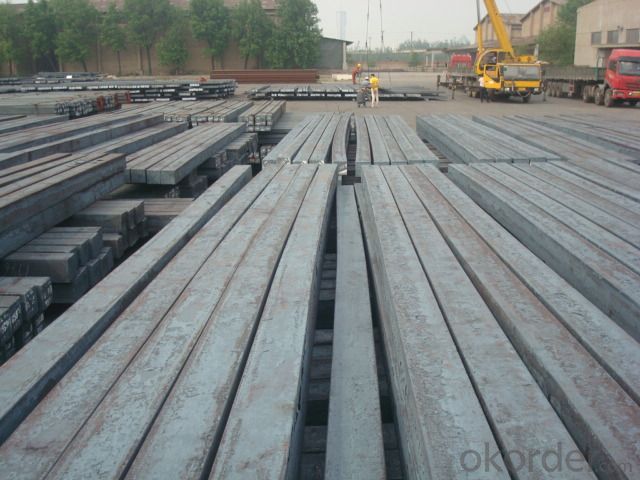
5.Usage
Billets, or ingots (as they sometimes referred to), are not of practical use until they have been formed into more functional shapes and sizes. While they have already been put in the furnace, they still require a series of shaping and molding procedures such as hot and cold working, milling and cutting before they are sold in hardware stores, or used for different applications. The unformed billets, however, can be used in striking currency such as coins and as reserves, similar to gold bars.
6.Detailed specification
Hot rolled billet steel
Size: 50x50mm-180x180mm
Steel Grade: 3SP, 5SP,Q195,Q235,Q255,Q275 Length:3m-12m
MOQ: 1000MT/size
Payment term: TT or LC
Packing: in bulk , bundle
Shipment: by container , bulk vessel
Packaging Details: bundles with steel strips or as customers's requirements
Delivery time: 15-30 days after the deposit
Loading port:Tianjin, or other port China
Origin : China
Inspection:Third party inspection before loading.
- Q: How are steel billets used in the production of automotive fuel systems?
- Steel billets are used in the production of automotive fuel systems as they are melted and shaped into various components such as fuel tanks, fuel rails, and fuel pump housings. These billets provide the necessary strength, durability, and corrosion resistance required for these critical components, ensuring the safe storage and delivery of fuel in vehicles.
- Q: What are the different forging methods used for steel billets?
- There are several different forging methods commonly used for steel billets, including open die forging, closed die forging, and upset forging. Open die forging involves shaping the steel billet between flat or shaped dies, allowing for greater flexibility in forming complex shapes. Closed die forging, on the other hand, involves placing the billet between two dies that have a pre-determined shape, resulting in a more precise final product. Upset forging is a method used to increase the diameter or thickness of the billet by compressing it axially, often used to create shorter and thicker components.
- Q: How are steel billets inspected for internal and surface defects?
- To ensure the quality and integrity of steel billets, various methods are employed to inspect them for internal and surface defects. One commonly used technique for detecting internal flaws is ultrasonic testing. This involves transmitting high-frequency sound waves through the billet and analyzing the reflections received to identify any discontinuities or defects such as cracks, voids, or inclusions. Another method used to inspect internal defects is magnetic particle inspection. This process entails applying a magnetic field to the billet and coating it with iron particles. If there are any internal defects or cracks, they will disrupt the magnetic field, causing the iron particles to accumulate at these locations and become visible under appropriate lighting conditions. When it comes to surface defects, visual inspection is typically the initial step. Expert inspectors visually examine the billet for any visible irregularities like cracks, pits, scratches, or deformities. They may also utilize specialized tools like magnifying glasses or microscopes to ensure a thorough examination. In addition to visual inspection, non-destructive testing techniques can also be employed to detect surface defects. One commonly used method is dye penetrant testing. In this procedure, a colored liquid dye is applied to the surface of the billet. The dye seeps into any surface defects and is later removed, leaving behind a visible indication of the defect. This technique is particularly effective in detecting surface cracks or discontinuities. Another technique used for surface defect inspection is eddy current testing. This technique is based on the principle that a fluctuating magnetic field induces electrical currents in conductive materials like steel. Any surface defects or irregularities will disrupt the induced currents, which can be detected by monitoring changes in the electrical properties of the billet. Eddy current testing is commonly employed to identify surface cracks, pits, or variations in thickness. In conclusion, a combination of these inspection methods allows for a comprehensive evaluation of steel billets, ensuring that both internal and surface defects are identified and addressed before the billets undergo further processing or are used in various applications.
- Q: How are steel billets used in the manufacturing of kitchen appliances?
- Kitchen appliances require steel billets as they possess versatile properties and can be molded into different shapes and sizes. These billets, typically made from low carbon steel, act as the raw material for manufacturing kitchen appliances like stoves, ovens, refrigerators, and dishwashers. The production process starts by heating the steel billets to a high temperature, known as annealing, to enhance their formability and ductility. Once the desired temperature is achieved, the billets are passed through rolling mills to reduce their size and shape them accordingly. This hot rolling process forms steel sheets or plates, which can be further processed. Next, these steel sheets or plates are cut, bent, and formed into various components of kitchen appliances. For instance, the body of a refrigerator or oven is often made by shaping and welding steel sheets together to create a strong and durable structure. Similarly, the burners and grates of a stove are typically cast and machined from steel billets to acquire the desired shape. The use of steel billets in manufacturing kitchen appliances offers numerous advantages. Steel is renowned for its strength, durability, and resistance to corrosion, making it an excellent choice for appliances that endure frequent use and exposure to moisture. Additionally, steel is easy to clean and maintain, ensuring the longevity and hygiene of the appliances. Moreover, steel is a cost-effective material for kitchen appliance manufacturing. Its widespread availability and comparatively low production costs contribute to making kitchen appliances more affordable for consumers. In conclusion, steel billets play a vital role in the production of kitchen appliances by providing a versatile and cost-effective material that can be shaped, formed, and assembled into different components. Their strength, durability, and resistance to corrosion make steel billets an ideal choice for manufacturing high-quality kitchen appliances that meet the demands of modern households.
- Q: How are steel billets used in the production of mining conveyors?
- The production of mining conveyors heavily relies on steel billets, which are essential for creating sturdy and durable components. Mining conveyors are responsible for transporting bulk materials like coal, ore, and gravel across long distances. To withstand the harsh conditions of a mining environment, these conveyors require robustness and durability. Conveyor rollers, crucial for the conveyor system's functionality, are manufactured using steel billets as the raw material. These rollers provide support and guidance to the conveyor belt. Initially, the steel billets undergo a heating process, which enhances their malleability, making shaping easier. Once heated, they are rolled into desired shapes to form the conveyor rollers. By incorporating steel billets into the production of mining conveyors, the resulting rollers possess excellent strength and resistance to wear and tear. The steel's properties, including toughness and hardness, make it highly suitable for enduring heavy loads and abrasive materials. Moreover, steel billets offer customization options to cater to specific requirements. Each mining operation may have unique needs in terms of conveyor dimensions, load capacities, and environmental conditions. With the use of steel billets, manufacturers can produce conveyor rollers of various sizes and specifications, ensuring a tailored fit for each mining operation. In conclusion, steel billets play a vital role in the production of mining conveyors as they serve as the primary material for manufacturing conveyor rollers. These rollers are indispensable for supporting and guiding the conveyor belt, enabling efficient and reliable transportation of bulk materials in the mining industry. By utilizing steel billets, the resulting conveyor rollers are strong, durable, and capable of withstanding the harsh conditions prevalent in the mining sector.
- Q: What are the different methods of steel billet surface grinding?
- There are several methods of steel billet surface grinding, including abrasive grinding, belt grinding, and centerless grinding.
- Q: Are steel billets prone to corrosion?
- Yes, steel billets are prone to corrosion. Steel is primarily made from iron, and iron is susceptible to rusting and oxidation when exposed to moisture and oxygen. Therefore, steel billets, which are the raw form of steel used for further processing, can corrode if not properly protected or maintained.
- Q: How are steel billets used in the manufacturing of chemical processing equipment?
- The manufacturing process of chemical processing equipment heavily relies on steel billets. These billets act as the primary material that undergoes various transformations to become the final products necessary for chemical processing plants. To begin with, steel billets are crucial for the production of high-quality steel plates. These plates form the structural framework of chemical processing equipment. They are meticulously cut, shaped, and welded together to create vessels, reactors, and storage tanks. The exceptional strength and durability of steel make it the ideal choice for containing corrosive chemicals and withstanding the extreme pressures and temperatures experienced in chemical processing. Not only that, but steel billets also play a vital role in the creation of pipes and fittings used in chemical processing plants. These billets are heated and passed through a series of rollers to form seamless or welded pipes. The resulting pipes are then subjected to further processing and fabrication to meet specific requirements such as corrosion resistance, heat resistance, and pressure ratings. Additionally, steel billets are instrumental in the manufacturing of various components of chemical processing equipment, including valves, flanges, and other fittings. These components are essential for controlling the flow of chemicals, regulating pressure, and connecting different parts of the processing system. Steel billets are machined, forged, or cast to create these components, ensuring their strength, reliability, and resistance against chemical corrosion. To sum up, steel billets are an indispensable part of the manufacturing process for chemical processing equipment. Their versatility, strength, and resistance to corrosion make them the preferred choice for constructing the structural framework, pipes, and fittings needed in chemical processing plants. By utilizing steel billets, manufacturers can guarantee the reliability, safety, and longevity of the equipment used in the chemical industry.
- Q: What are the common defects in billet? What's the cause?
- Five, X ray inspection, porosity, ultrasonic testing:One, 5, magnetic particle inspection, the back of the dent; 6, overheating and over burning: 1, penetrant inspection;Four. 2. The size of the weld does not meet the requirements and slag inclusion; 3 high-energy X-ray inspection, lamellar tearing and R ray flaw detection; 2;Five;Two: 1, arc crater;Methods for inspection of weld defects;
- Q: What is the role of steel billets in the manufacturing of hydraulic cylinders?
- Steel billets play a crucial role in the manufacturing of hydraulic cylinders as they are the raw material used to create the cylinder body. The billets are heated and then shaped into the desired cylindrical form through processes like hot rolling or forging. This allows for the production of strong and durable cylinders that can withstand high pressure and various operating conditions.
Send your message to us
Prime Steel Billet Q275, 20MnSi, 5SP,Q235 for great sale
- Loading Port:
- Tianjin
- Payment Terms:
- TT OR LC
- Min Order Qty:
- 1000 m.t.
- Supply Capability:
- 20000 m.t./month
OKorder Service Pledge
OKorder Financial Service
Similar products
Hot products
Hot Searches
Related keywords
